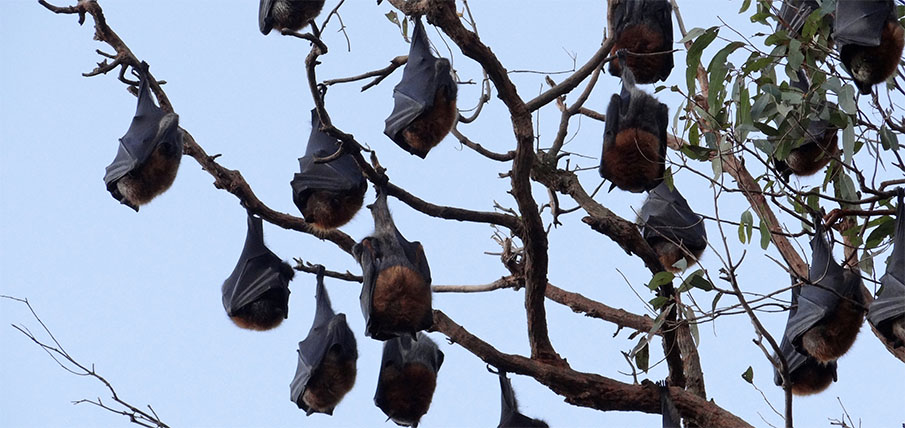Learn about Adelaide's Grey-headed Flying Fox colony from Zoos SA staff at the Adelaide Zoo

We spoke to staff at the Adelaide Zoo to learn more about Adelaide's Grey-headed Flying Fox colony, including why they are in Adelaide, what they eat, what challenges they face, how Zoos SA deal with injured bats and how the Adelaide Zoo supports the colony.
Adelaide's Grey-headed Flying Foxes
The Grey-headed Flying Fox is the largest bat in Australia and one of the largest in the world. A significant group of flying foxes, a protected species listed as vulnerable, arrived in Adelaide in 2010 from the eastern states and established a permanent colony in the botanic gardens near the Adelaide Zoo. Their numbers have grown from around 10,000 in the early years to more than 28,000 now.
The series of videos below gives more insight into this fascinating species.
Grey Headed Flying Foxes – Introduction
Dr Phil Ainsley, Director, Adelaide Zoo, introduces us to the Grey Headed Flying Fox colony in Botanic Park out the front of Adelaide Zoo. He tells us how they got to Adelaide and why they now call the Adelaide Botanic Gardens their home.
In the early 2000s drought had badly affected Queensland and NSW (their usual habitat), causing the Foxes to search for alternative habitats with ready access to water and food.
The initial colony of a few hundred bats took up residence in the Botanic Gardens but they soon moved to the Aleppo pines outside of the Adelaide Zoo, where the colony still is today.
Grey Headed Flying Foxes – food and habitat
Dr Phil Ainsley, Director, Adelaide Zoo, discusses how the Botanic Park colony of Grey Headed Flying Foxes searches for food.
While they roost in the trees by day, they fly out at night in search of food within an average range of 20km.
Adelaide wasn’t historically their habitat, but urbanisation has built a great area for them to live in. With the Torrens nearby for water and many of their favourite food trees such as Morteon Bay figs throughout the CBD, the colony has what it needs.
Grey Headed Flying Foxes – Reproduction
Dr Phil Ainsley, Director, Adelaide Zoo, discusses the low reproduction and survival rate of the Grey Headed Flying Fox. He also explains how the pups are at first highly dependent on their mother, before they graduate to ‘creche’ at around 2 months old.
Grey Headed Flying Foxes – Threatened species
Dr Phil Ainsley, Director, Adelaide Zoo, explains how the Grey Headed Flying Fox has been recognised through legislation at both State and Federal level as a threatened and protected species.
The processes that have threatened the Flying Fox are climate change, reduction in habitat, reduction of their food sources as well as the species low reproduction and survival rate of their young.
Dealing with injuries to Grey-headed flying foxes
Di Hakof, Manager Animal Health Department, Zoos SA, explains some of the common injuries they see with Adelaide's Grey-headed Flying Foxes and the medical intervention they provide.
Di also discusses what members of the public should do if they come across an injured or distressed Grey Headed Flying Fox.
Grey Headed Flying Foxes – Zoos SA Support
Di Hakof, Manager Animal Health Department, Zoos SA, discusses how Zoos SA have adapted to having the Grey-headed Flying Fox colony in such close proximity to Adelaide Zoo.
One of the main adaptations was providing an airconditioned space for both the animals and their rescuers, particularly in extreme heat events.
One of the positives of the colony is the important role they can now play in assisting our environment and bio-diversity in their role as plant pollinators.
What to do if you see an injured Grey-headed Flying Fox
The welfare of the protected native Grey-headed Flying Foxes, and all other animals, is important to us.
Report power outages to SA Power Networks - 13 13 66.
Report injured animals to either of the following organisations:
- Bat Rescue SA on 0475 132 093
- Fauna Rescue Flying Fox and Microbat Team on 8486 1139
Do not touch injured animals if you have not been trained how to do it safely.
Related articles
Outages linked to Grey-headed Flyinf Foxes expected to increase in 2022